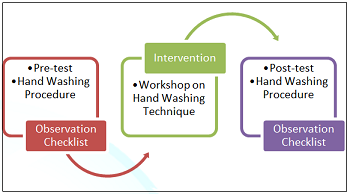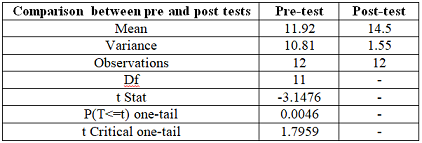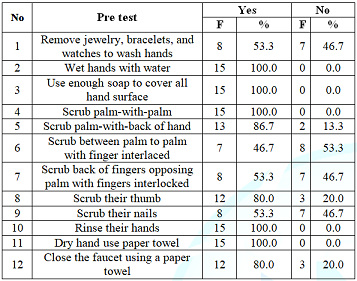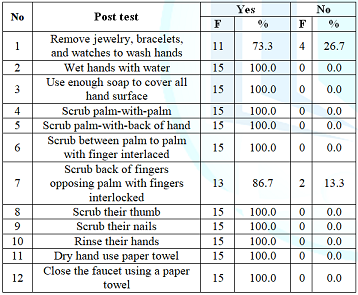Introduction
Hand washing is an easy and cost-effective method in
controlling the spread of Hospital Acquired
Infections (HAIs). However, compliance with the performance of
correct and effective hand hygiene has not been adequate among nursing
students, especially in clinical settings. Several studies have demonstrated
that periodic re-education that comprises knowledge and demonstration
components is necessary to keep the compliance of hand washing at effective
levels.
Background and
Rationale of the Study
Hand washing or hand hygiene is known as the most
important intervention in order to prevent the risk of HAIs prevalence.
According to the World Health
Organization (WHO) 2019 [1] hand washing compliance
is able to lower the rate of prevalence for Healthcare-Associated Infections
(HCAIs) in clinical area; especially hospital setting [2]. In the healthcare
setting, it is identified that nurses as the healthcare professionals that
provides nursing care accounts for approximately 80% direct contact to patients
in clinical area that involves personal and intimate care activities [3]. It is
shown that, nurses spent most of their working time with the patients as
compared with other healthcare professionals [4]. So, it is compulsory for the
nursing students making contact with the patients in the clinical area during
the clinical placement where it is part of their educational course as
requirements [5]. During the clinical placement or attachment period, the
nursing students are frequently exposed to variety of sources of infection such
as the Coronavirus [3].
However, previous study found that the nursing
students had a low level of knowledge related to the prevention and control of infections
in clinical area [6]. Hand washing is
known as the most efficient and economical method in order to prevent HAIs and
HCAIs, such as the Coronavirus [3,7]. It is essential for the healthcare
workers to conduct hand washing procedure before and after any patient care
procedure [5]. Previous studies had shown that, the implementation of different
approaches such as workshop, hands-out, and posters in order to enhance the
theoretical and practical knowledge on hand washing shows the variability in
the efficacy between educational and interventional approaches worldwide
[2,5-8].
Problem
Statement
Other than that, based on observation in clinical
areas, most of the nursing students undergoing clinical attachment or placement
are unable to implement the right technique of hand washing either before or
after deliver nursing care
procedures. Hence, it is essential to conduct a study to evaluate the hand
washing techniques of the undergraduate nursing students before graduated and
working as the registered staff nurse in clinical area.
The hand washing practice significantly associated
with the HAIs where the correct hand washing practice is significantly able to
reduce risks and rates of HAIs and HCAIs in clinical area, especially in
hospital settings [9]. It is because increasing in the prevalence of HAIs and
HCAIs may become the burden of morbidity, mortality and increase in the length
of hospitalization among patients in hospital setting [10]. During the clinical
attachment or placement period, nursing students are compulsory to serve
nursing care services to the patients [9]. Thus, nursing students also have an
inevitable role in the spreading of HAIs and HCAIs [3,5].
Objective,
Purpose, Hypothesis and Research Questions
The objective of this study is to evaluate the
effectiveness of the workshop on hand washing techniques among post-qualified
undergraduate nursing students. The purpose however is to pave new avenues in
preventing HAIs and HCAIs from nursing students through workshops on hand
washing. Hence, it is hypothesized that there is a significant effectiveness of
workshop on promoting hand washing techniques among nursing students. On
account of the objectives, purposes, and hypothesis, this study deems to ask:
· What
are the steps of hand washing techniques do student nurses perform before a workshop
is implemented?
· What
are the steps of hand washing techniques do student nurses perform after a
workshop is implemented?
Methods
In this study, a pre and post quasi experimental
study design was used. This study observed the effectiveness of a workshop on
the techniques of hand washing among nursing students. The intervention was the
workshop on hand washing technique, and then after a pre-observation test the
participants are to attend a workshop. After the workshop, all of the
participants needed to undergo a post-test and again using exactly the same
observational checklist found on the appendix. This method in order to observe
the effectiveness of an intervention-workshops on hand washing techniques-using
a checklist on hand washing techniques as recommended by the WHO (2009)
guideline [1]. Hand washing workshop was introduced as an intervention because
it is a factual knowledge that can be observed for many healthcare
professionals especially among nursing students [7,9,11-13].
Study Population,
Sampling Technique and Sample Size
In this study, simple random sampling was used in
order to choose and recruit all the student nurses from the 4th
year. The study populations were undergraduate nurses at SIME Darby Medical
Center located in Selangor, Malaysia. The inclusion criteria limited nursing
students who were currently being in year 4 and have experienced or undergone
clinical placements. All the participants of this study were randomly chosen
from a specific number through an automated process. A total of 15 students
were selected to enroll in the experimental study.
Research
Instruments and Data Collection Procedure
The research instrument of this study is known as a
checklist where it had been adapted from the study conducted by Felix and Miyadahira
(2009) [9] with the title Evaluation of the Hand Washing
Technique Held by Students from the Nursing Graduation Course
integrated with the WHO (2009) [1] guideline on the right hand washing
techniques. The checklist (appendix) had listed the several steps of hand
washing techniques and it is reliable to be followed by all healthcare workers
worldwide when demonstrating the proper techniques of hand washing.
Figure
1
had shown the flow of the data collection procedure. The duration of this
workshop is 2 hours. Then, in the third session, after the workshop session,
all of the participants again need to show how they wash their hand in clinical
area from the beginning till the end of the process of hand washing procedure
known as post-test. During the pre and post-test session, the hand washing
technique was observed from the participants, and then filled the checklist
based on the reference from the WHO guideline of 2009.

Figure 1: Flow of the Data Collection Procedure.
Data Analysis
Statistical analysis of the data is done using
descriptive statistics utilizing frequency distribution and percentage. This
was done to determine the extent to which the participants were able to
correctly perform each of the procedural steps. In order to determine the
effect of the hand hygiene workshop, data between pre-test and post-test were
compared. Data analysis was done using the Data Analysis tool pack of Microsoft
Excel 2016 and the Statistical Packages for Social Sciences
version 21. A t-test was used since the samples are small and there are two
samples such as the pre and post-test [14]. However, the t-test on comparing
means of the two groups will only be assumed reliable if the observed subjects
are normally distributed which this study has failed to analyzed [14].
Ethical Approval
Ethical approval for this research and its designs
were approved by University of Hertfordshire (UH) with research protocol number
acHSK0081 SDU 03002. Participants were asked to sign the consent and they were
given the autonomy to withdraw from the study at any time without further
questions. Confidentiality and anonymity were also considered by not revealing
the participants name on the observation checklist but by using serial numbers
and their results were only shown to them filed in a safe locked and
undisclosed.
Results
Table
1
identified the pre-test result regarding the hand washing technique performed
by the nursing students addressing the first research question. Before
attending the workshop, a majority of the participants were not able to perform
the steps perfectly. Felix and Miyadahira (2009) [9] also said that wetting
hands with water, using enough soap to cover the hands, scrubbing,
palm-with-palm, rinsing hands, and drying with paper are the steps where
nursing students usually forget or were just complacent in doing it properly. Table 2 answered the second research
question and identified that after the workshop, 10 out of the 12 steps in the
procedure checklist were performed by the nursing students.
These were: (2) Wet hands with water; (3) Use enough
soap to cover all hand surface; (4) Scrub palm-with-palm; (5) Scrub
palm-with-back of hand; (6) Scrub between palm to palm with finger interlaced;
(8) Scrub their thumb; (9) Scrub their nails; (10) Rinse their hands; (11) Dry
hand use paper towel; (12) Close the faucet using a paper towel. Although there
was improvement in the performance, two of the steps still did not garner full
performance of the participants such as removal of the jewelry, bracelet, and
watches. Similarly, Felix and Miyadahira (2009) [9] also said that nursing
students do not realize the importance of those steps. Table 3 identified that there was a significant effectiveness of
work shop on hand washing techniques (p0.0046).

Table 3: Comparison between pre and post-tests.
Strengths and
Limitations
The key advantage on a quasi experimental study
design is that all the confounding variables are easily controlled in the
process of investigation. However, this quasi experimental study design is
limited to an interventional way that is very often unpractical to control as
all the essential factors actually can significantly influence the
intervention. Consequently, the results might be biased as it is limited to a
single cohort. That is why the appropriate way to use this quasi-experimental
design (though unpractical) is to control and limit
confounding variables such as the student year level, and their evidences of
being exposed to clinical placements.
Finally, this study cannot be generalized as a
worldwide acceptable finding. However, should it be used in general, it must be
taken with caution considering the demography of the experimental subjects such
as their year level and the setting of the cohort.
Nevertheless, in general, this study showed that
student nurses must be well-prepared to exhibit professionalism,
accountability, and the provision of safe and quality nursing
care
[15]. In any aspects and areas of nursing practice, hand hygiene is a core and
basic skill that should be possessed, which impacts not only on own health and
safety but more importantly, on the patients well-being [16]. On a more
specific aspect, hand hygiene has a great impact on the mortality and morbidity
of patients in all health care
setting [17]. Therefore, the correct technique of hand hygiene is one way to
exhibit safe and quality patient care [15].
It has been noted that over time, there is a
decrease in performance of hand hygiene among post-qualified undergraduate
student nurses [7,9]. Mahmood, Verma and Khan (2015) [11] agreed with Felix and
Miyadahira (2009) [9] and Hong and Jang (2016) [7] that is neglected to be
studied and demonstrated properly by nursing students in their clinical
practices. The frequency of performing hand washing as well as the correct
procedure in doing such tend to decline over time [15,17]. That is why most of
the literatures reviewed had also addressed the findings of this study that education
and training should be continuously done [7,9,11,12].
Implications to
Practice
Hand hygiene is considered as the single most
important and effective method in preventing HAIs [18]. The techniques of hand
hygiene, which includes hand rubbing and hand washing are included in the basic
curriculum of nursing education [16,18]. One of the trainings that need to be
emphasized was the removal of jewelry and watches as it is a very important
step in hand-washing procedure and according to this study is often missed by
nursing students (n4, 26.7%) even after the workshops are already been given.
Watches, jewelries, and chains harbour trap microorganisms that may be
transferred through skin-to-skin contacts, like Coronavirus, Staphylococcus and
Pseudomonas [3,19].
Khodavaisy, et al., (2011) [20] also noted these
findings in their study on the contamination of Intensive Care
Unit
(ICU) health care workers hands and rings and recommended that medical and
hospital personnel should remove watches, jewelries, and bracelets before
washing their hands [16,19]. It is therefore very important to emphasize the
performance of this step given that this is one of the most forgotten steps by
the student nurses prior to the workshop, and that the presence of watches and
jewelries can affect the quality of hand hygiene [18]. There are instances, as
shown in the results, that students are generally able to perform hand washing
procedure but missed critical steps especially on certain parts of the hands.
The WHO (2009) [1] emphasizes six (6) critical areas
that should be included when doing hand hygiene: palm, dorsum, between fingers,
back of fingers, thumb, and fingertips. A study by Skodová, et al., (2015) [18]
evaluated the hand hygiene quality of hand hygiene
techniques among health care workers and found out thumbs and fingertips are
the ones that are least covered. Similarly, in this study, some participants
were still able to miss in the steps that include fingers (n2, 13.3%) even
after the workshop has already been given.
The importance of education and re-education on hand
hygiene strategies were highlighted on the results of the study [11]. It was
found out that there is an improvement in the performance of hand washing among
the participants after they underwent and participated in the hand washing
workshop, with the increase in pre-test mean of 11.92 to 14.50 in post-test. In
congruence with this studys results, several other studies have demonstrated
similar effectiveness on the use of re-education and workshop in enhancing the
performance of hand hygiene skills [7,9,12,13].
Arise, et al., (2017) [21] noted in their study that
continued direct observation and feedback on hand hygiene significantly
decreased the incidence of infection. A similar study involving workshop
intended for medical students also demonstrated an increase in performance
among the participants after the workshop, and further concluded that educational
programs can improve knowledge and performance in short and
long time periods [13,22]. Furthermore, Randle, et al., (2014) [23] noted that
adherence to hand hygiene could be improved and sustained through educational
intervention.
Conclusion
It can be concluded that a hand washing workshop is
an effective strategy in enhancing the skills of nursing students in
effectively performing hand washing. A periodic re-education workshop or
program regarding hand hygiene is recommended for health care personnel across
all levels in order to maintain the quality of hand hygiene performance.
Recommendation
The result of this study further highlights the
importance of workshops and re-education in enhancing the skills of a
healthcare provider. This does not only apply to handwashing but could be true
with any clinical skills. Hence, the following recommendations are made:
· Creation
of a handwashing workshop module and other tools that would refresh the
knowledge and skills of nurses and other healthcare providers in performing
handwashing, highlighting the need to perform the first step.
· Regular
re-education schedule in order to constantly update students and healthcare
providers on the techniques of hand washing.
· Further
research to determine practice as a factor in the performance of hand hygiene
during the 5 moments as emphasized by the WHO (2009) [1].
Furthermore, the first step in the procedure, which
is the removal of jewelry, watches, and bracelets, is the step that has the
least improvement post-workshop. It can also be recommended that although hand
hygiene practice is already included in the curriculum, a periodic re-education
through workshop is necessary in maintaining the quality of hand hygiene
performance. It is essential for the nursing students able to implementing the
right and proper technique of hand washing in clinical area before graduated.
The right and proper hand washing techniques are able to reduce risk and rate
of prevalence healthcare-associated infections in clinical area. Next, the continuous
and consistent education or training should be providing to the nursing
students so that may ensure they having the latest and adequate theoretical and
practical knowledge regarding hand washing technique.
The nursing school and healthcare organization that
involve in the clinical placement period should emphasized on the formal and
informal education regarding hand washing technique so that nursing student
compliance with the right and proper hand washing technique. The results of
this study are promising enough to warrant recommendations on the enhancement
of hand washing practices among health care providers. However, it is to be
noted that certain factors may make this studys generalizability be limited.
· This
study involved student nurses as participants. Therefore, certain caution must
be done in applying these results to all members of health care team members.
· The
sample size of the participants is limited. Although they are homogenous, the
power of the sample size may not be enough to warrant a complete generalization
to the entire population of student nurses.
· The
lack of a control group may limit the rigour of the study given the fact that
the participants have taken the same evaluation methods in pre-test and
post-test. Hence, there may be a certain degree of a gap as to which the effect
of the pre-test on the participants performance on the post-test.
Nevertheless, this study follows carefully the
research protocol and principles ascribed to an observational,
quasi-experimental research. Hence, the study itself possesses a reliable
academic merit.
Acknowledgment
The authors would like to acknowledge the University
of Hertfordshire for the ethical approval; and specifically, to Carolyn Hill
for the academic supervision. Lastly, we would like to thank Edu Punay for the
final editing of this written research.
References
- World Health Organization Guidelines on hand hygiene in healthcare, First Global Patient Safety Challenge, Clean Care is Safer Care (2009) A world health alliance for safer healthcare, Geneva.
- Aizen
E and Zlotver E. Prediction of falls in rehabilitation and acute care geriatric
setting (2013) J Clin Gerontology Geriatrics 4: 57-61. https://doi.org/10.1016/j.jcgg.2013.01.001
- World Health
Organization, Coronavirus disease (COVID-19) outbreak (2019) Geneva.
- Al
Kadi A and Salati S. Hand Hygiene Practices among Medical Students (2012)
Interdiscip Perspect Infect Dis 1-6. https://doi.org/10.1155/2012/679129
- Al-Khawaldeh
O, Al-Hussami M and Darawad M. Influence of Nursing Students Handwashing
Knowledge, Beliefs, and Attitudes on Their Handwashing Compliance (2015) Health
7: 572-579. https://doi.org/10.4236/health.2015.75068
- Foote
A and El-Masri M. Self-perceived hand hygiene practices among undergraduate
nursing students (2015) J Res Nurs 21: 8-19. https://doi.org/10.1177/1744987115606959
- Hong S
and Jang H. The Effect of a Hand Washing Education Program for Pre-practicum
Nursing Students (2016) Int J Software Engineering Applications 10: 161-170.
- Abdalrahman I, Shamat S, Mamoun S, Abdelraheem R, Salah, E, et al. Educational sessions may not be enough to improve knowledge about hand hygiene: Assessing the knowledge about hand hygiene of health workers before and after an educational workshop in Sudan (2018) F1000 research 7: 449. https://doi.org/10.12688/f1000research.13029.1
- Felix CC and Miyadahira AM. Evaluation of the handwashing technique held by students from the nursing graduation course (2009) Rev Esc Nurs 43: 139-145. https://doi.org/10.1590/s0080-62342009000100018
- Nasirudeen AMA, Koh JWN, Lau ALC, Li W, Lim LS, et al. Hand hygiene knowledge and practices of nursing students in Singapore (2012) Am J Infect Control 40: e241-e243. https://doi.org/10.1016/j.ajic.2012.02.026
- Mahmood
S, Verma R and Khan M. Hand hygiene practices among nursing students:
importance of improving current training programs (2015) Int J Community Med
Public Health 2: 466-471. https://doi.org/10.18203/2394-6040.ijcmph20151031
- Brosio
F, Kuhdari P, Stefanati A, Sulcaj N, Lupi S, et al. Knowledge and Behaviour of
Nursing Students on the Prevention of Healthcare Associated Infections (2017) J
Prev Med Hyg 58: 99-104.
- Škodová
M, Gimeno-Benítez A, Martínez-Redondo E, Morán-Cortés J, Jiménez-Romano R, et
al. Hand hygiene technique quality evaluation in nursing and medicine students
of two academic courses (2015) Rev Latino-Am Enfermagem 23: 708-717. https://doi.org/10.1590/0104-1169.0459.2607
- Kim H.
Statistical notes for clinical researchers: assessing normal distribution (2)
using skewness and kurtosis (2013) Restor Dent Endod 1: 52-54. https://doi.org/10.5395/rde.2013.38.1.52
- Rhodes
MK, Morris AH and Lazenby RB. Nursing at its best: competent and caring (2011)
Online J Issues Nurs 16: 10.
- Sopjani I, Jahn P and Behrens J. Hand Hygiene Training and Its Impact on the Knowledge of Undergraduate Nursing Students in Kosovo (2017) Glob J Health Sci 9: 142. https://doi.org/10.5539/gjhs.v9n4p142
- Mathur P. Hand hygiene: back to the basics of infection control (2011) Indian J Med Res 134: 611-620. https://doi.org/10.4103/0971-5916.90985
- Skodová M, Urra FG, Benítez AG, Romano MR and Ortiz AG. Hand hygiene assessment in the workplace using a UV lamp (2015) Am J Infect Control 43: 1360-1362. https://doi.org/10.1016/j.ajic.2015.07.003
- Isitua
C, Igbinidu O and Imariabe O. Microorganisms associated with gold jewelries
worn by students in the University of Benin, ugbowo campus, Nigeria (2012) Res
J Recent Sci 1: 46-50.
- Khodavaisy
S, Nabili M, Davari B and Vahedi M. Evaluation of bacterial and fungal contamination
in the health care workers hands and rings in the intensive care unit (2011) J
Prev Med Hyg 52: 215-218. https://www.ncbi.nlm.nih.gov/pubmed/22442928
- Arise K, Nishizaki S, Morita T, Yagi Y and Takeuchi S. Continued direct observation and feedback of hand hygiene adherence can decrease incidence of meticillin-resistant Staphylococcus aureus infection/colonization (2017) Int J Infect Control 13. https://doi.org/10.3396/IJIC.v13i2.010.17
- Rezaee R, Danaei M and Askarian M. The efficacy of teaching hand hygiene to medical students: an interventional study (2014) International J Academic Res Business Social Sci 4. https://doi.org/10.6007/IJARBSS/v4-i9/1138
- Randle
J, Arthur A, Vaughan N, Wharrad H and Windle R. An observational study of hand
hygiene adherence following the introduction of an education intervention
(2014) J Infect Prev 15: 142-147. https://doi.org/10.1177/1757177414531057
*Corresponding author
Regidor III Dioso, Department of Nursing, Lincoln University College, Petaling Jaya, Malaysia, E-mail: duke@lincoln.edu.my
Citation
Mohamad ABN, Muda CK, Ab Khadir NAS, Suchi U and Dioso IIIR. Effectiveness of workshop on hand washing techniques among undergraduate nursing students: a quasi experimental study (2020) Nursing and Health Care 5: 10-14.Keywords
Hand washing technique, Healthcare,
Nursing, Undergraduate nursing students, Educational program, Hand hygiene,
Observational study.


 PDF
PDF

